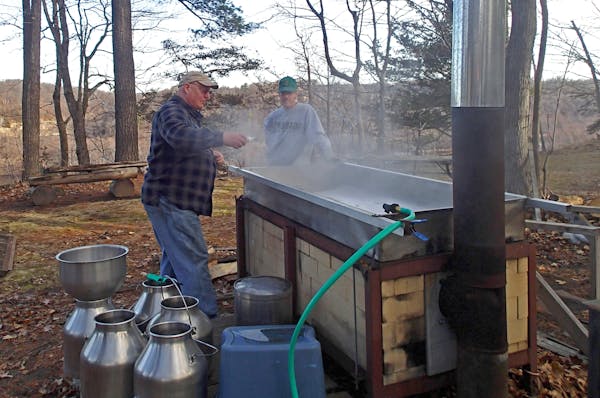Maple sap flow is triggered by thawing days on the heels of freezing nights. The best flows in southern Minnesota tend to happen between March and the first few days of April, at which point leaf buds swell and sap becomes bitter.
Last year the sap-collecting season began March 7 and ended April 4. The best sap runs often occur when a frosty night is followed by a sunny day with temperatures reaching into the 40s or higher. Late afternoon is a good time to collect the day's flow.
The sap will flow from any wound in the sapwood — a hole bored into the tree or into a broken twig. Sugar maples, black maples and boxelders, also known as ash-leaved maples, are best for tapping. The red maple and silver maple are options, but their sap is less sweet. A forest of many maple trees together is called a sugarbush. Maples are tapped using a carpenter's brace with a 3/8-inch bit. Trunks smaller than 10 inches should not be tapped. Holes 2-inches deep are bored into the tree trunk about three feet above the ground. A small metal or wooden tube called a spile is inserted into the hole and tapped lightly with a hammer for a snug fit. The spile supports the container and carries sap into it.
Maple syrup is made by boiling the maple sap in a shallow pan until it contains a high percentage of sugar (67 percent). When a candy thermometer reads 7 degrees above the boiling point of water, the syrup is ready to be strained and bottled. Usually 30 to 40 gallons of sap are required to produce a single gallon of syrup. The amount depends on the sugar content of the sap, which is mostly water.
Jim Gilbert's Nature Notes are heard on WCCO Radio at 7:15 a.m. Sundays. His observations have been part of the Minnesota Weatherguide Environment Calendars since 1977, and he is the author of five books on nature in Minnesota. He taught and worked as a naturalist for 50 years.
Bevy of defensive playmakers are available in Round 2 of the NFL draft after historic offensive run
Twins bring momentum on road despite Angels Stadium struggles

Neal: McCarthy mania sweeps through Vikings draft party

Pretty much a must-win Game 3 for Suns as series moves to Phoenix

